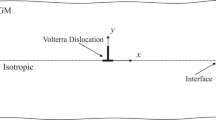Summary
Fast crack propagation in dynamically loaded plane structures is investigated. The major point of interest is the evolution of the crack trajectory under the influence of stress waves which are generated and repeatedly reflected at the specimen boundaries. Since these waves may lead to arbitrary mixed-mode and time-dependent loading of the crack tip, both the direction and speed of crack advance are determined from a fracture criterion.
Starting point is a system of time-domain boundary integral equations which describes the initial boundary value problem of a linear elastic body containing an arbitrarily growing crack. The unknown displacements and/or tractions on the exterior boundary and the displacement jumps across the crack are computed numerically by a collocation method in conjunction with a time-stepping scheme. Crack growth is modelled by adding new boundary elements of constant length at the running crack tip.
The method proves to be of sufficient accuracy when applied to problems treated with other numerical techniques. Moreover, the simulation of dynamic crack propagation under various geometry and loading conditions enables the reproduction and analysis of complex phenomena observed experimentally.
Similar content being viewed by others
References
Achenbach, J. D.: Wave propagation in elastic solids. Amsterdam New York: North Holland 1973.
Belytschko, T., Tabbara, M.: Dynamic fracture using element-free Galerkin methods. Int. J. Num. Meth. Eng.39, 923–938 (1996).
Dally, J. W., Fourney, W. L., Irwin, G. R.: On the uniqueness of the stress intensity factor — crack velocity relationship. Int. J. Fract.27, 159–168 (1985).
Dominguez, J.: Boundary elements in dynamics. Southampton: Computational Mechanics Publications 1993.
Erdogan, F., Sih, G. C.: On the crack extension in plates under plane loading and transverse shear. J. Bas. Eng.85 D, 519–525 (1963).
Eringen, A. C., Suhubi, E. S.: Elastodynamics II. New York: Academic Press 1975.
Fedelinski, P., Aliabadi, M. H., Rooke, D. P.: The time-domain DBEM for rapidly growing cracks. Int. J. Num. Meth. Eng.40, 1555–1572 (1997).
Freund, L. B.: Dynamic fracture mechanics, 1st ed. Cambridge: Cambridge University Press 1990.
Gallego, R., Dominguez, J.: Dynamic crack propagation analysis by moving singular boundary elements. ASME. J. Appl. Mech.59, 159–162 (1992).
Knauss, W. G., Ravi-Chandar, K.: Some basic problems in stress wave dominated fracture. Int. J. Fract.27, 127–143 (1985).
Koller, M. G., Bonnet, M., Madariaga, R.: Modelling of dynamic crack propagation using timedomain boundary integral equations. Wave Motion16, 339–366 (1992).
Nishioka, T., Atluri, S. N.: Numerical modelling of dynamic crack propagation in finite bodies by moving singular elements, Part II: Results. ASME J. Appl. Mech.47, 577–582 (1980).
Ramulu, M., Kobayashi, A. S.: Mechanics of crack curving and branching — a dynamic fracture analysis. Int. J. Fract.27, 187–201 (1985).
Seelig, Th: On the simulation of dynamic crack propagation using a time-domain boundary element method. PhD thesis, University of Darmstadt, 1997 (in German).
Seelig, Th., Gross, D.: Analysis of dynamic crack propagation using a time-domain boundary integral equation method. Int. J. Solids Struct.34, 2087–2103 (1997).
Swenson, D. V., Ingraffea, A. R.: Modelling mixed-mode dynamic crack propagation using finite elements: Theory and applications. Comput. Mech.3, 381–397 (1988).
Xu, X.-P., Needleman, A.: Numerical simulation of fast crack growth in brittle solids. J. Mech. Phys. Solids42, 1397–1434 (1994).
Zhang, Ch., A novel derivation of non-hypersingular time-domain BIEs for transient elastodynamic crack analysis. Int. J. Solids Struct.28, 267–281 (1991).
Zhang, Ch., Gross, D.: A non-hypersingular time-domain BIEM for 3-D transient elastodynamic crack analysis. Int. J. Num. Meth. Eng.36, 2997–3017 (1993).
Author information
Authors and Affiliations
Rights and permissions
About this article
Cite this article
Seelig, T., Gross, D. On the stress wave induced curving of fast running cracks — a numerical study by a time-domain boundary element method. Acta Mechanica 132, 47–61 (1999). https://doi.org/10.1007/BF01186959
Received:
Revised:
Issue Date:
DOI: https://doi.org/10.1007/BF01186959




